Freeborn County, Minnesota
| Freeborn County, Minnesota | |
|---|---|
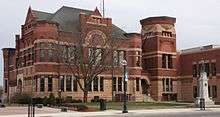 Freeborn County Courthouse | |
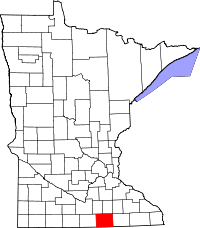 Location in the U.S. state of Minnesota | |
 Minnesota's location in the U.S. | |
| Founded | February 20, 1855[1] |
| Named for | William Freeborn |
| Seat | Albert Lea |
| Largest city | Albert Lea |
| Area | |
| • Total | 722 sq mi (1,870 km2) |
| • Land | 707 sq mi (1,831 km2) |
| • Water | 15 sq mi (39 km2), 2.1% |
| Population (est.) | |
| • (2016) | 30,446 |
| • Density | 44/sq mi (17/km2) |
| Congressional district | 1st |
| Time zone | Central: UTC−6/−5 |
| Website |
www |
Freeborn County is a county located in the State of Minnesota. As of the 2010 census, the population was 31,255.[2] Its county seat is Albert Lea.[3]
Freeborn County comprises the Albert Lea, MN Micropolitan Statistical Area.
History
Freeborn County was established in 1855.[4] It is named for William Freeborn, an early Minnesota politician.[5]
Geography
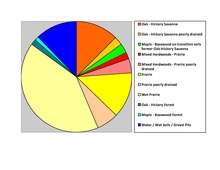
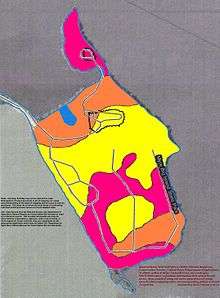
According to the U.S. Census Bureau, the county has a total area of 722 square miles (1,870 km2), of which 707 square miles (1,830 km2) is land and 15 square miles (39 km2) (2.1%) is water.[7] The Le Sueur River, a tributary of the Minnesota River, begins in the northern part of the county.
Lakes
Freeborn County has 16 lakes, mostly in the western half of the county.
- Albert Lea Lake: Albert Lea Township and Hayward Township
- Bear Lake: Nunda Township
- Church Lake: Pickerel Lake Township
- Fountain Lake: Abert Lea Township and Bancroft Township
- Freeborn Lake: Carlston Township and Freeborn Township
- Geneva Lake: Geneva Township and Bath Township
- Goose Lake: Albert Lea Township
- Halls Lake: Manchester Township
- Hickory Lake: Moscow Township
- Lower Twin Lake: Nunda Township
- Pickerel Lake: Albert Lea Township and Pickerel Township
- School Section Lake: Manchester Township
- State Line Lake: Nunda Township
- Sugar Lake: Manchester Township
- Upper Twin Lake: Pickerel Township and Nunda Township
- White Lake: Pickerel Lake Township and Albert Lea Township
Major highways
Adjacent counties
- Steele County (northeast)
- Mower County (east)
- Worth County, Iowa (south)
- Winnebago County, Iowa (southwest)
- Faribault County (west)
- Waseca County (northwest)
Demographics
| Historical population | |||
|---|---|---|---|
| Census | Pop. | %± | |
| 1860 | 3,367 | — | |
| 1870 | 10,578 | 214.2% | |
| 1880 | 16,069 | 51.9% | |
| 1890 | 17,962 | 11.8% | |
| 1900 | 21,838 | 21.6% | |
| 1910 | 22,282 | 2.0% | |
| 1920 | 24,692 | 10.8% | |
| 1930 | 28,741 | 16.4% | |
| 1940 | 31,780 | 10.6% | |
| 1950 | 34,517 | 8.6% | |
| 1960 | 37,891 | 9.8% | |
| 1970 | 38,064 | 0.5% | |
| 1980 | 36,329 | −4.6% | |
| 1990 | 33,060 | −9.0% | |
| 2000 | 32,584 | −1.4% | |
| 2010 | 31,255 | −4.1% | |
| Est. 2016 | 30,446 | [8] | −2.6% |
| U.S. Decennial Census[9] 1790-1960[10] 1900-1990[11] 1990-2000[12] 2010-2016[2] | |||
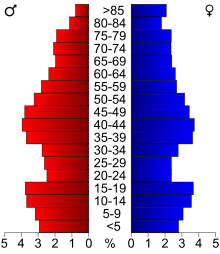
As of the 2000 census, there were 32,584 people, 13,356 households, and 9,015 families residing in the county. The population density was 46 people per square mile (18/km²). There were 13,996 housing units at an average density of 20 per square mile (8/km²). The racial makeup of the county was 95.22% White, 0.24% Black or African American, 0.20% Native American, 0.55% Asian, 0.02% Pacific Islander, 2.92% from other races, and 0.85% from two or more races. 6.29% of the population were Hispanic or Latino of any race. 34.8% were of Norwegian, 26.2% German and 5.8% Danish ancestry.
There were 13,356 households out of which 29.10% had children under the age of 18 living with them, 56.50% were married couples living together, 7.50% had a female householder with no husband present, and 32.50% were non-families. 28.20% of all households were made up of individuals and 14.00% had someone living alone who was 65 years of age or older. The average household size was 2.40 and the average family size was 2.92.
In the county, the population was spread out with 24.00% under the age of 18, 7.50% from 18 to 24, 25.50% from 25 to 44, 24.10% from 45 to 64, and 18.90% who were 65 years of age or older. The median age was 40 years. For every 100 females there were 96.60 males. For every 100 females age 18 and over, there were 95.00 males.
The median income for a household in the county was $36,964, and the median income for a family was $45,142. Males had a median income of $31,491 versus $21,799 for females. The per capita income for the county was $18,325. About 5.60% of families and 8.40% of the population were below the poverty line, including 9.00% of those under age 18 and 9.10% of those age 65 or over.
Communities
Cities
Townships
- Albert Lea Township
- Alden Township
- Bancroft Township
- Bath Township
- Carlston Township
- Freeborn Township
- Freeman Township
- Geneva Township
- Hartland Township
- Hayward Township
- London Township
- Manchester Township
- Mansfield Township
- Moscow Township
- Newry Township
- Nunda Township
- Oakland Township
- Pickerel Lake Township
- Riceland Township
- Shell Rock Township
Unincorporated communities
- Armstrong
- Corning (partial)
- Gordonsville
- Mansfield
- Maple Island
- Moscow
- Oakland
- Petran
Politics
| Year | Republican | Democratic | Third parties |
|---|---|---|---|
| 2016 | 54.9% 8,808 | 37.6% 6,041 | 7.5% 1,202 |
| 2012 | 41.7% 6,969 | 55.8% 9,326 | 2.5% 411 |
| 2008 | 40.3% 6,955 | 57.4% 9,915 | 2.4% 410 |
| 2004 | 43.5% 7,681 | 55.1% 9,733 | 1.4% 252 |
| 2000 | 42.4% 6,843 | 52.8% 8,514 | 4.9% 782 |
| 1996 | 32.3% 5,166 | 52.9% 8,458 | 14.8% 2,364 |
| 1992 | 28.6% 5,089 | 43.6% 7,759 | 27.9% 4,965 |
| 1988 | 44.6% 7,226 | 54.5% 8,836 | 1.0% 156 |
| 1984 | 47.1% 8,413 | 52.3% 9,338 | 0.7% 116 |
| 1980 | 47.7% 8,475 | 46.2% 8,212 | 6.2% 1,098 |
| 1976 | 45.6% 8,220 | 52.6% 9,470 | 1.8% 328 |
| 1972 | 56.9% 9,747 | 41.8% 7,163 | 1.3% 220 |
| 1968 | 44.2% 7,315 | 52.4% 8,671 | 3.5% 577 |
| 1964 | 36.7% 6,136 | 63.2% 10,554 | 0.1% 19 |
| 1960 | 52.7% 8,970 | 47.1% 8,018 | 0.1% 22 |
| 1956 | 51.6% 7,632 | 48.3% 7,138 | 0.1% 11 |
| 1952 | 56.3% 8,450 | 43.4% 6,525 | 0.3% 46 |
| 1948 | 39.5% 5,238 | 58.9% 7,825 | 1.6% 213 |
| 1944 | 46.8% 5,728 | 53.0% 6,486 | 0.3% 32 |
| 1940 | 48.9% 6,683 | 50.8% 6,942 | 0.4% 55 |
| 1936 | 37.8% 4,653 | 60.0% 7,378 | 2.2% 274 |
| 1932 | 44.6% 4,931 | 52.8% 5,838 | 2.6% 283 |
| 1928 | 72.7% 7,815 | 26.6% 2,859 | 0.7% 76 |
| 1924 | 63.8% 6,139 | 5.0% 480 | 31.3% 3,011 |
| 1920 | 82.0% 6,772 | 13.7% 1,131 | 4.4% 360 |
| 1916 | 60.1% 2,418 | 33.5% 1,347 | 6.5% 260 |
| 1912 | 17.0% 672 | 22.3% 880 | 60.7% 2,392 |
| 1908 | 61.1% 2,465 | 24.2% 976 | 14.7% 591 |
| 1904 | 78.2% 2,876 | 12.5% 461 | 9.3% 341 |
| 1900 | 74.2% 2,934 | 21.2% 838 | 4.7% 184 |
| 1896 | 72.3% 3,400 | 25.1% 1,179 | 2.7% 127 |
| 1892 | 61.3% 2,004 | 22.7% 743 | 16.0% 524 |
See also
References
- ↑ "Minnesota Place Names". Minnesota Historical Society. Retrieved March 18, 2014.
- 1 2 "State & County QuickFacts". United States Census Bureau. Archived from the original on July 10, 2011. Retrieved August 31, 2013.
- ↑ "Find a County". National Association of Counties. Archived from the original on 2011-05-31. Retrieved 2011-06-07.
- ↑ Upham, Warren (1920). Minnesota Geographic Names: Their Origin and Historic Significance. Minnesota Historical Society. p. 198.
- ↑ Gannett, Henry (1905). The Origin of Certain Place Names in the United States. Govt. Print. Off. p. 131.
- ↑ Nelson, Steven (2011). Savanna Soils of Minnesota. Minnesota: Self. pp 43–48. ISBN 978-0-615-50320-2
- ↑ "2010 Census Gazetteer Files". United States Census Bureau. August 22, 2012. Archived from the original on October 6, 2014. Retrieved October 15, 2014.
- ↑ "Population and Housing Unit Estimates". Retrieved June 9, 2017.
- ↑ "U.S. Decennial Census". United States Census Bureau. Archived from the original on May 12, 2015. Retrieved October 15, 2014.
- ↑ "Historical Census Browser". University of Virginia Library. Retrieved October 15, 2014.
- ↑ "Population of Counties by Decennial Census: 1900 to 1990". United States Census Bureau. Retrieved October 15, 2014.
- ↑ "Census 2000 PHC-T-4. Ranking Tables for Counties: 1990 and 2000" (PDF). United States Census Bureau. Retrieved October 15, 2014.
- ↑ Leip, David. "Dave Leip's Atlas of U.S. Presidential Elections". uselectionatlas.org. Retrieved 18 September 2018.